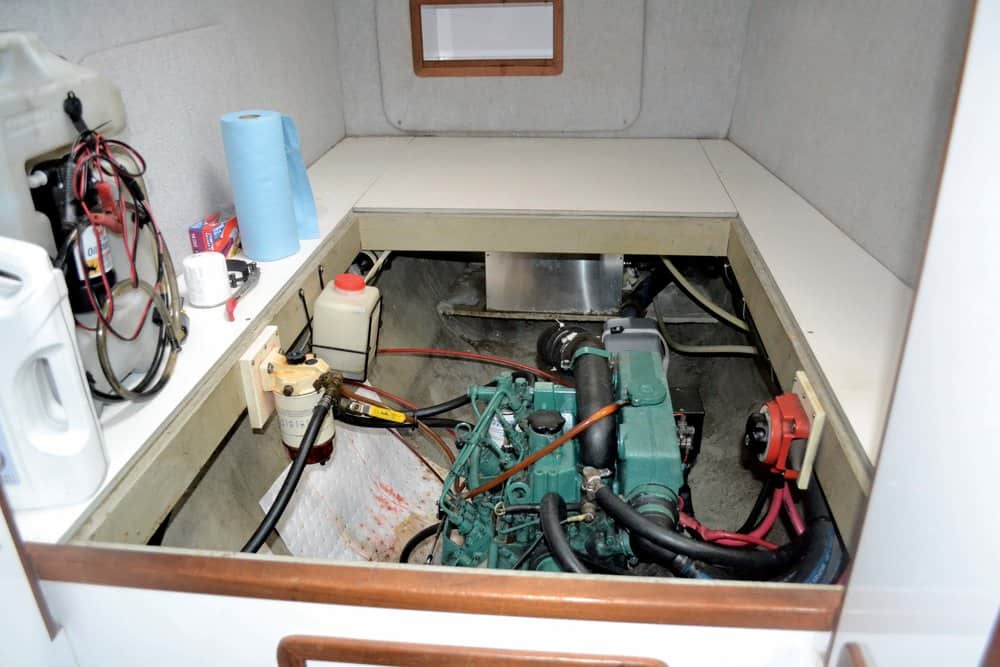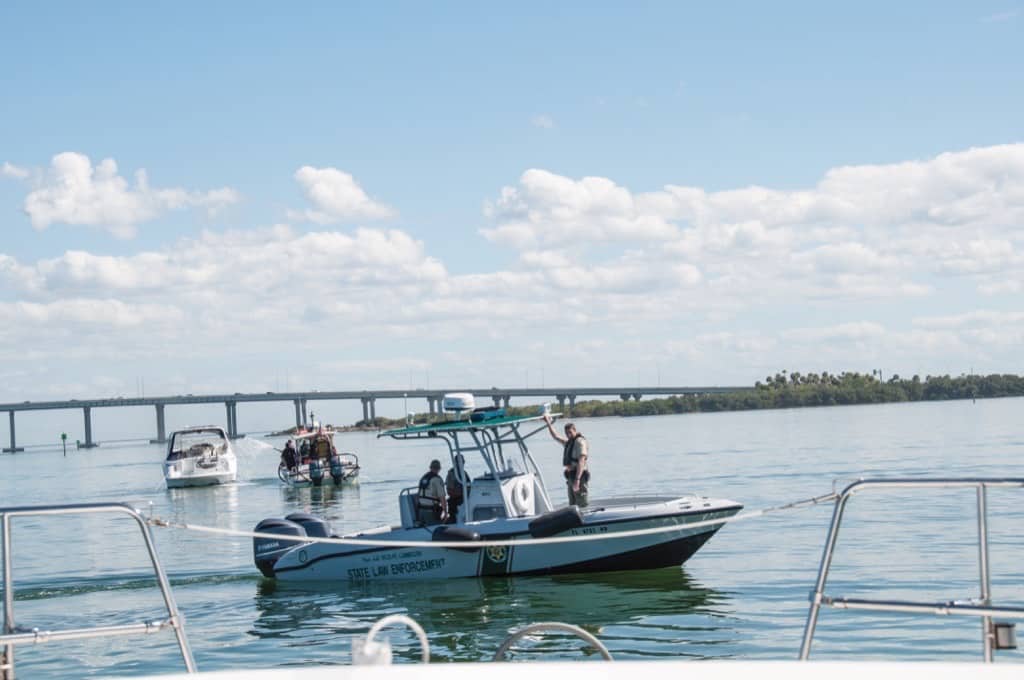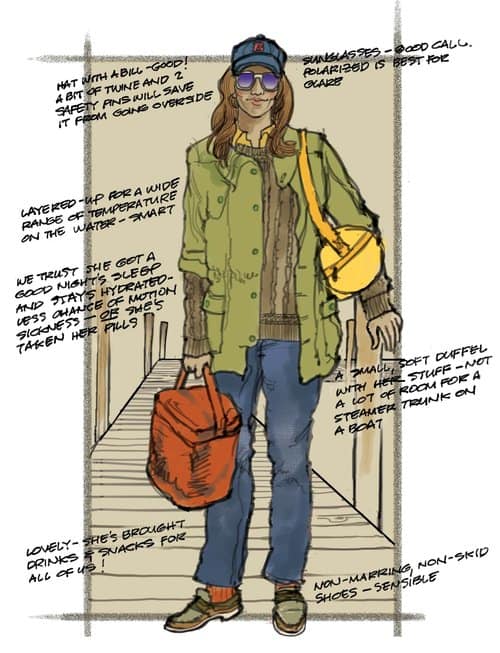by Jody Argo Schroath
Zen and the Performance Art of Do-It-Yourself Marine Diesel Maintenance
Photo by Ann Levelle.Listen up folks, because this is a harrowing tale of standard marine diesel maintenance on the move. Oil change. Oil filters. Fuel filters. Impellers. It’s not rocket science, but in hands of this author, it has all the earmarks of a three-stage moon shot.
According to my logbook, it began May 11–12 in New Bern, North Carolina. The entry says simply, “Changed oil Mon-Tues.” I don’t remember why it took me two days. I do have two engines, but I usually do it in one fell swoop. Pump out the old oil. Unscrew the old oil filter into a baggie and then screw on the new one. Fill with oil. Bump engines to fill new filters. Recheck levels. Done. In any case, as I recall, it went about as smoothly as the entry implies, not counting twice dropping the oil-extraction tube’s age-petrified cap into the port engine’s dark, unseeable and nearly inaccessible nether regions. But then I usually do that, so probably thought it unnecessary to comment. (Though I do plenty enough commenting at the time.)
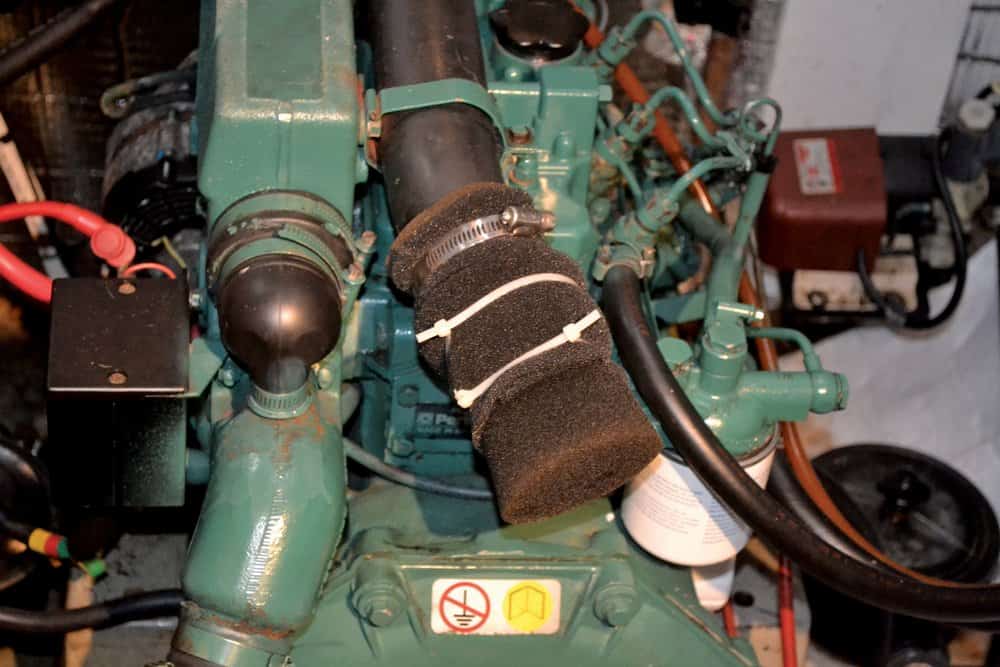
I have just remembered why it took me two days for an oil change. While doing the first engine, I couldn’t help but notice that the foam air filter had torn itself nearly in two. Grrr! After a trip to the downtown hardware store, thanks to the knowledge of friends who were also staying in New Bern, I returned with a house air conditioning filter, which I cut into strips and cable-tied in place. Exhausted by this uncharacteristic burst of inventiveness, I abandoned the field and went out to dinner with the same hardware-store-savvy friends.
The next morning, the second oil change went without a hitch. That air filter was fine, and the next morning, the fur-bearing crew, Bindi and Sammy, and I left New Bern to rejoin the ICW. The impellers and fuel filters would have to wait. That night, we docked at River Forest in Belhaven to get fuel, and the following morning set out to do the Albemarle Loop.
In tiny Columbia, North Carolina, the first stop on the Loop, I got to the impellers. Again, changing the impellers is not the worst job on a boat. You shut off the raw-water intake, unscrew the water-pump cover, pull out the old impeller, clean the old gasket off the cap, make sure everything is nice and clean, lubricate the new impeller tips and maybe the inside casing (depending on whom you read) and new gasket, persuade the new impeller to go in properly and in the right direction, replace the cap with its new gasket, turn the water back on and Bob’s your uncle. The only issue to all of this on Moment of Zen is that the impeller on the starboard engine is offset to the left of the access door so you have to stand on your head and grow a couple of new arms to line up and screw on the cap. Here too, I routinely drop these tiny screws like summer rain while trying to line up the cap.
So, on my second rainy day in Columbia, I decided to tackle the starboard impeller first. Off came the cap and out came the old impeller. Golly. One of the impeller arms was cracked. One was torn. And one was missing. Not good. I was going to have to find it before I went any farther. I pulled out my diesel books to look for clues. Two were no help, but Nigel Calder said it would most likely be lodged at the entrance to the heat exchanger. I took a deep breath and removed the hose clamps from the hoses in front of it and with some trepidation worked them apart. (I am never optimistic about getting things back together.) I reached my fingers into the section closest to the heat exchanger core and was astonished to feel a rubber chunk at the bottom. I was even more astonished when I managed to extract it, also with my fingers, with only moderate difficulty.
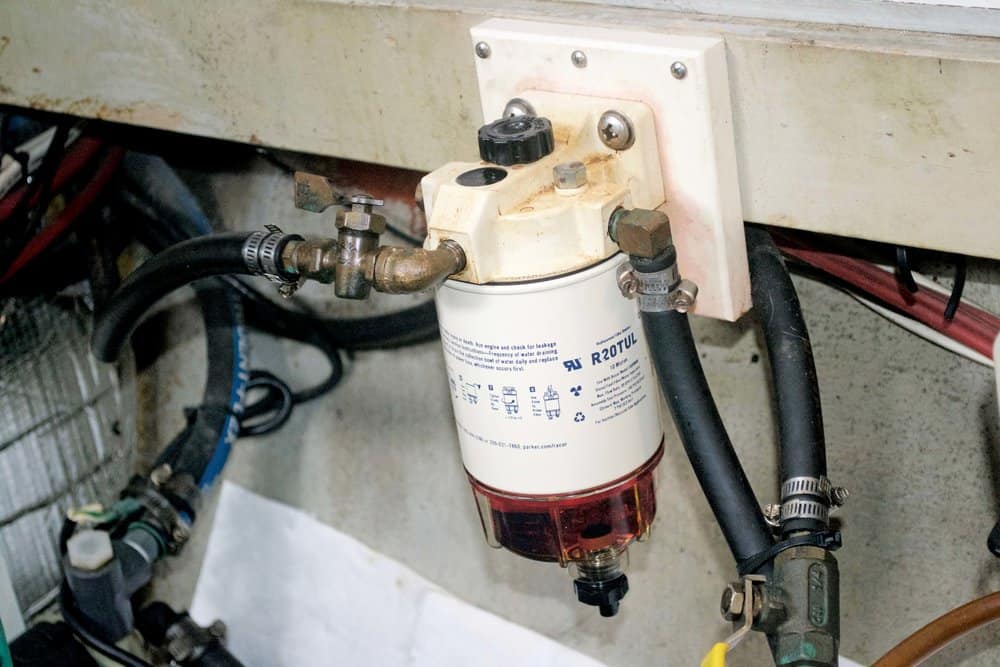
“Darn, Calder,” I thought, “Now I’m going to have to start paying attention to what he says.” Note: This is foreshadowing and never bodes well. The impeller on the port engine was fine, not even a crack, so I’ll move on.
We come now to my least favorite engine maintenance job, which is changing the fuel filters. Happily, this only needs to be done very 200 hours, rather than every 100 like the oil. Often, I have a trained professional do this one, which is lovely, but has a couple of drawbacks. The first drawback is that the ratio of marine diesel mechanics to marine diesel engines is appalling, which means it can take practically an entire boating season to lure one onto your vessel. This is even worse when you are traveling, at least for me because I never know when I’m going to be anywhere, and I’m always late getting to wherever I’m going. There are exceptions. I once got to Zimmerman’s in Southport, N.C., to come and do it within an hour of arriving at Southport Marina. I could have kissed them, but it hardly seemed appropriate, so I took Sammy and Bindi out for ice cream instead.
The second drawback is that, in my experience, marine diesel mechanics are always stronger than I am. I’m good with that, but what it means is that later, when I try to unscrew anything they’ve touched, from the oil filter to the oil filler cap, it’s like trying to pull the sword from the stone, with me not being King Arthur.
From Columbia, I went on to Edenton on the northwestern corner of Albemarle Sound. It rained, and the wind blew from the northwest. Despite that and the fact that the dockmaster is not allowed to actually help you dock, Edenton is a perfectly charming town. And before I left a couple of days later, the sun even came out, and it was even more charming.
Because it was raining, and because it really, really, really had to be done, I decided Edenton was just the place to change the fuel filters. It was May 13, according to my logbook. Here is the way it starts: “Changed stbd fuel filters! Whew!” I had a lot more to say, but I can’t quote it, because two days later, on May 15, while I was off doing the laundry at Albemarle Plantation Marina, Junior Seaman Sammy tore that page out of the log book and ate a great deal of it. I have no idea why, although I have a theory that he resents being illiterate. In any case, I have what’s left of the page here in front of me now in a plastic baggie. Eventually I’ll get around to taping it back into the book. The only other bits on the subject that I can make out are “Took ½ hr to get cup off [Racor]” and “finally used knife then screwdriver.”
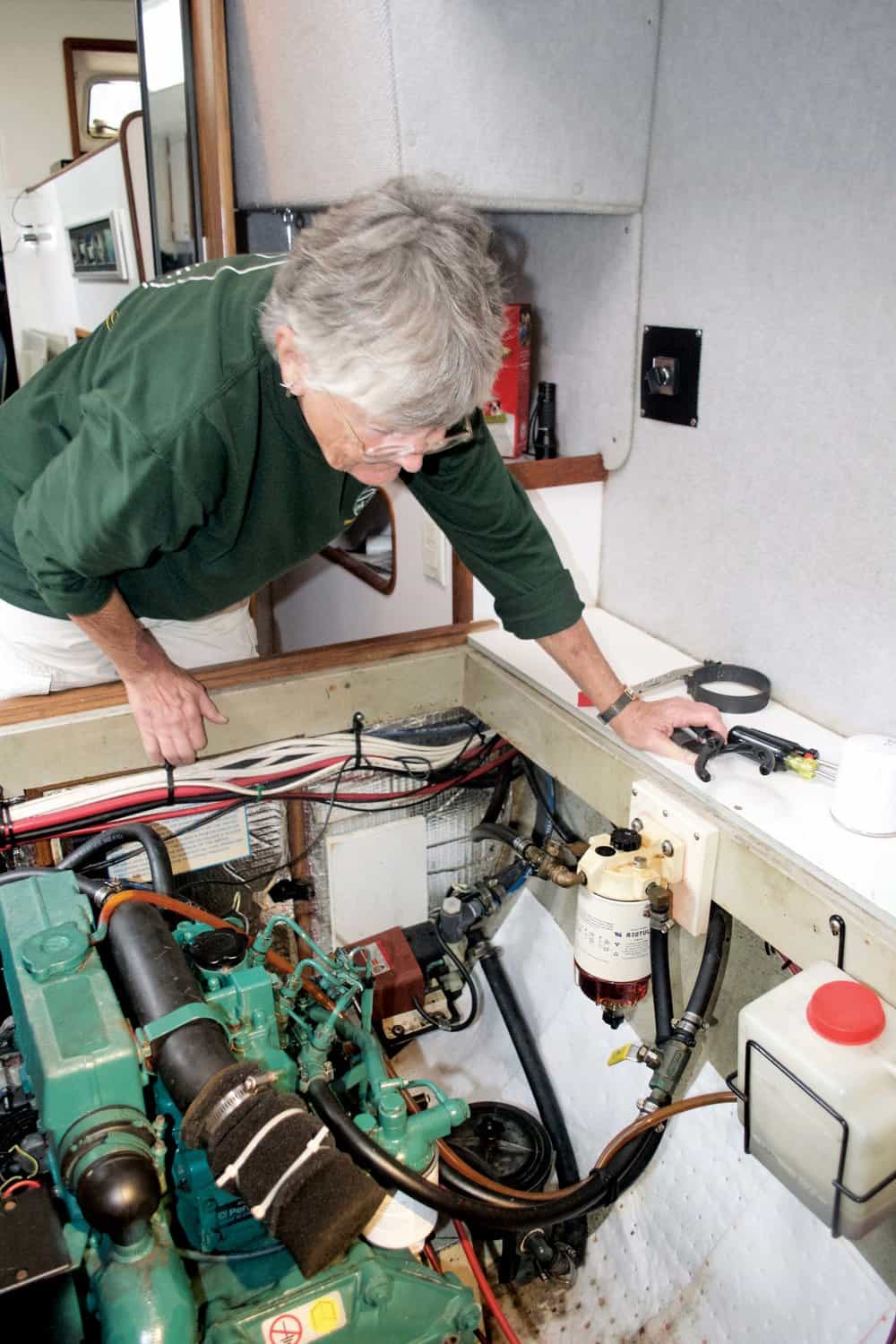
Now I can’t prove it, but I believe this stuck cup issue goes back, at least in part, to the sword in the stone problem I mentioned earlier. It did take me half an hour, and I did try a lot of different methods, only two of which were a knife and screwdriver, before I finally sprung it free.
This, however, was not the worst of my problems. Let’s go back to that foreshadowing. Because Calder had been right about where to find the errant impeller arm, I decided to follow his advice viz a viz fuel filters: “Always bleed them. Never fill them.” I had always filled them, which had been plenty messy enough for my taste. But okay, I’d do it right this time. So, when I finally got the old Racor and the cup off and cleaned the cup super-thoroughly (Calder), I put everything back, opened the fuel line, unscrewed the thumb pump at the top and then opened the bleeding screw. The idea is to pump the fuel into the filter until diesel oozes out of the bleeding screw. Then you keep going until you don’t see any more air bubbles coming out with the fuel. What the books don’t say is to be careful not to open the bleeding screw too far. So, there I was pumping, pumping, pumping, and the fuel was oozing, oozing, oozing, when all of a sudden, the bleeding screw flew off like the top of Mount St. Helens and a geyser of diesel fuel gushed out like Old Faithful. Holy natural disaster!
Happily, I keep the floor and sides of the engine compartments covered with pads to catch oil and whatnot, and I have a big oil absorbing sock between the engine and the bilge drain, so it was a localized natural disaster. Muttering darkly, I set about gathering up all the affected pads and put them in the bag with the old filter and drained fuel. I stripped off my oily clothes and dumped them into a sink full of Dawn and water. Then I got out a new set of pads and a clean set of maintenance clothes and went in search of the peripatetic bleeding screw. Ten mad minutes later, I found it five feet away behind the raw-water through-hull valve. I was practically giddy with relief . . . or diesel fumes. I screwed it back on tight (but not too tight), thinking that if that hadn’t bled out all the air, nothing short of a nuclear explosion would.
I moved on to the secondary filter. That deserves a story all its own for the tightness of its fit, fullness of the fuel line from all my pumping and its refusal to stop burping air bubbles, but I will spare you. By this time, I had moved past colorful language and self-criticism to a simple birdlike repetition of “Nevermore!” with the occasional “Never, ever, ever!” If Calder had walked in during this period, I could not have answered for my actions, though since he no doubt has King Arthur capabilities, it would have come to nothing.
By the time I had retightened the secondary filter bleeding screw and tidied up the engine compartment, I didn’t have the heart to see if the engine would start. I simply took a shower, walked the dogs, drank several beers very quickly, and went to bed.
The next day was Mother’s Day, and it was still raining. So, I changed the fuel filters on the port engine. Hey, I know what I said, but how could it be any worse? And, indeed, aside from spending another half hour getting the cup off the bottom of the primary filter, it went without notable incident. In the afternoon, the sun came out and with it every mother, father, child and 17 cousins in eastern North Carolina. Edenton was so full it nearly tilted into the Albemarle. It was lovely, and the dogs and I got out and enjoyed it thoroughly.
The following day, May 15, I stood at the helm and, after heating the glow plugs, turned the key on the starboard engine. Instantly, it burbled to life. I smiled in wonderment and cranked up the port engine.
I had finally finished my mighty hat trick of engine maintenance. It had taken me five days and four towns to do a one day job, but I had done it myself and learned, albeit the hard way, to bleed fuel filters, to repair a broken air filter and where to look for a missing impeller arm. And now I’m going to call Scott my mechanic and make an appointment for next October, because by that time those fuel filters will need changing again. But I feel confident that the next time I do it myself, I’ll know how to pull the sword out of the stone. All it takes is a hammer, knife, screwdriver, lock wrench and the big-girl nerve to give it a go.

